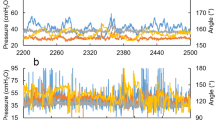Abstract
PURPOSE: The strength-duration test has been suggested as a means of assessing external anal sphincter function. This study was designed to investigate this claim by comparing the strength-duration test with established measures of external anal sphincter function. METHODS: Forty-nine females undergoing diagnostic anorectal testing (manometry, rectal sensation, electromyogram, pudendal nerve terminal motor latency, and endoanal ultrasound) also had the strength-duration test performed (which was repeated for each patient after a short rest period). RESULTS: The strength-duration test was repeatable. Statistically significant correlations were found between this test at pulse durations of 3 ms, 1 ms, and 0.3 ms with electromyographic activity of the external anal sphincter and with pressure in the anal canal during voluntary contraction. Significant correlations were found for durations of 100 ms, 30 ms, 10 ms, and 3 ms with the pudendal nerve terminal motor latency on the right and for the 3 ms and 0.3 ms durations with latency on the left. There were no correlations between the strength-duration test and resting pressure in the anal canal. CONCLUSION: The strength-duration test significantly correlates with the established measures of external anal sphincter function and its innervation. Therefore, this simple test appears to provide a simple measure of external anal sphincter denervation.
Similar content being viewed by others
References
DN Monk P Mills J Jeacock M Deakin A Cowie ES Kiff (1998) ArticleTitleCombining the strength-duration curve of the external anal sphincter with manometry for assessment of faecal incontinence. Br J Surg 85 1389–1393
ME Neill AG Parks M Swash (1981) ArticleTitlePhysiological studies of the anal sphincter musculature in faecal incontinence and rectal prolapse. Br J Surg 68 531–536
MJ Farthing JE Lennard-Jones (1978) ArticleTitleSensibility of the rectum to distension and the ano-rectal distension reflex in ulcerative colitis. Gut 19 64–69
D Taverner FG Smiddy (1959) ArticleTitleAn electromyographic study of the normal function of external anal sphincter and pelvic diaphragm. Dis Colon Rectum 2 153–160
E Kiff M Swash (1984) ArticleTitleSlowed conduction in the pudendal nerve in idiopathic (neurogenic) faecal incontinence. Br J Surg 71 614–616
AH Sultan MA Kamm CN Hudson CI Bartram (1994) ArticleTitleThird degree obstetric anal sphincter tears: BMJ 308 887–891
HL Duthie JM Watts (1965) ArticleTitleContribution of the external anal sphincter to the pressure zone in the anal canal. Gut 6 64–68
Author information
Authors and Affiliations
About this article
Cite this article
Mills, P.M., Hosker, G.L., Kiff, E.S. et al. Strength-Duration Testing of the External Anal Sphincter in Females with Anorectal Dysfunction. Dis Colon Rectum 45, 83–90 (2002). https://doi.org/10.1007/s10350-004-6118-z
Issue Date:
DOI: https://doi.org/10.1007/s10350-004-6118-z




